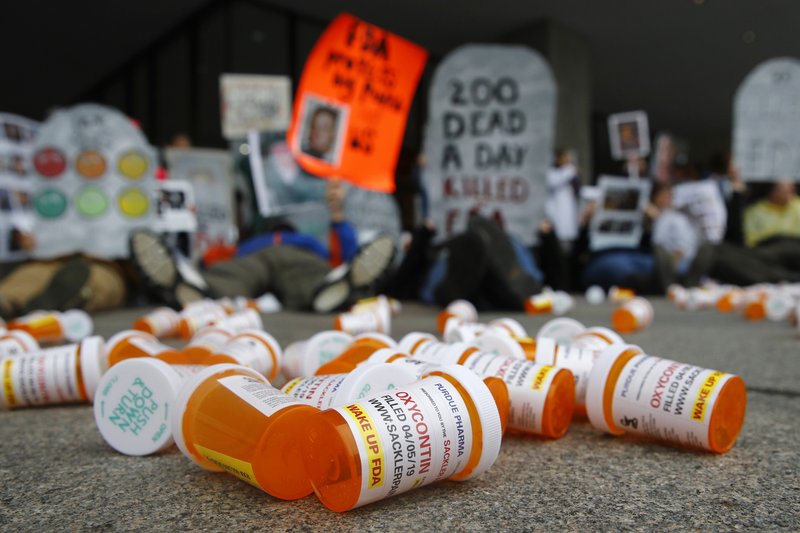NEW YORK -- U.S. overdose deaths last year fell for the first time in nearly three decades, preliminary statistics suggest.
The Centers for Disease Control and Prevention on Wednesday posted the provisional numbers showing nearly 68,000 drug overdose deaths were reported last year. The number may go up as more investigations are completed, but the agency expects the tally will end up below 69,000.
Overdose deaths had been climbing each year since 1990, topping 70,000 in 2017.
The numbers were celebrated by the U.S. secretary of health and human services. "Lives are being saved, and we're beginning to win the fight against this crisis," Alex Azar wrote in a tweet.
But the overdose death rate is still about seven times higher than it was a generation ago.
Researchers do not believe this is the start of a dramatic decline. Data from the first months of this year likely will show the decrease lessen a bit rather than accelerate, said Farida Ahmad of the CDC's National Center for Health Statistics.
The improvement was driven by a drop in deaths from heroin and prescription painkillers. Those falls were offset somewhat by continuing growth in deaths involving fentanyl, cocaine and psychostimulants like methamphetamines. Overdose deaths often involve more than one drug.
It can take months for authorities to complete toxicology tests and other elements of a death investigation involving drugs. And some states report faster than others. The CDC is expected to report more complete data later this year.
The current overdose epidemic has killed more people than any other in U.S. history, and it had been on a soaring trajectory. From 2014 to 2017, overdose deaths jumped by 5,000 or more each year.
Experts trace the epidemic's origins to 1995 and the marketing of the prescription painkiller OxyContin. It was meant to be safer and more effective than other prescription opioids, but some patients found themselves hooked and drug abusers found they could crush the tablets and snort or inject them to get high.
Newly released government figures suggest Purdue Pharma, which makes OxyContin, had plenty of help in flooding the U.S. with billions of pills even as overdose deaths were accelerating.
Records kept by the federal Drug Enforcement Administration show that 76 billion oxycodone and hydrocodone pills -- the vast majority of them generics, not brand names -- were shipped to U.S. pharmacies from 2006 to 2012.
The annual number swelled by more than 50% over that period of time even as the body count climbed. The powerful painkillers flowed faster even after Purdue Pharma was fined $635 million for falsely marketing OxyContin as less addictive than other opioids.
The newly released information shows in detail the flow of drugs from manufacturers to communities.
West Virginia, Kentucky, Tennessee and Nevada all received more than 50 pills for every man, woman and child each year. Several areas in the Appalachian region were shipped an average of well over 100 pills per person per year.
Nearly every state has filed a lawsuit, and most of them have focused on Purdue and members of the Sackler family, who own the Stamford, Conn.-based company and are major philanthropists whose donations to museums and universities have now come under scrutiny. Many local governments have also sued other drugmakers, distribution companies and pharmacies.
The lawsuits say that with the introduction of OxyContin, a time-released opioid, in 1995, Purdue created a new playbook to push the use of opioids for more patients and in higher doses.
But Purdue points out, accurately, that the company produced only a small fraction of the nation's opioids -- about 3% between 2006 and 2012, according to the data. Three companies -- SpecGX, Par Pharmaceutical and Activis Pharma -- that sold lower-priced generic drugs, including versions of OxyContin, combined to make 90% of the pills.
The three companies say they didn't market the drugs and were just meeting the demand of prescriptions filled out by doctors -- and that they didn't produce more than the DEA allowed.
As for the distributors, they contend they functioned as a delivery service and keep federal authorities apprised of the quantities of drugs being shipped.
Four companies -- McKesson Corp., Walgreens, Cardinal Health and AmerisourceBergen -- each distributed more than 10% of the opioids sent to pharmacies. McKesson distributed more than 18% of the nation's opioids from 2006 to 2012, the most of any company, but said it didn't push sales.
The figures are from the DEA's Automation of Reports and Consolidated Orders System. The DEA agreed to provide the data to lawyers in the opioid litigation but pushed judges to keep it from being made public.
Information for this article was contributed by Geoff Mulvihill, Matthew Perrone, Mike Balsamo and Claire Galofaro of The Associated Press.
A Section on 07/18/2019
